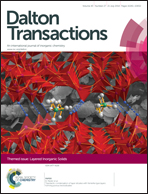Organization and intramolecular charge-transfer enhancement in tripodal tris[(pyridine-4-yl)phenyl]amine push–pull molecules by intercalation into layered materials bearing acidic functionalities†
Abstract
Two new intercalates of tris[4-(pyridin-4-yl)phenyl]amine (TPPA) with zirconium hydrogen phosphate and zirconium 4-sulfophenylphosphonate having formulae Zr(HPO4)2·0.21(C33H24N4)·2.5H2O and Zr(HO3SC6H4PO3)1.3(C6H5PO3)0.7·0.35(C33H24N4)·2.5H2O were prepared and characterized by thermogravimetry, IR spectroscopy, and powder X-ray diffraction. The TPPA molecule has been selected as a model tripodal push–pull system with three peripheral basic centers that may undergo protonation. Their protonation/quaternization afforded HTPPA/MeTPPA molecules with enhanced intramolecular charge-transfer (ICT), which has been documented by electrochemical measurements, UV-Vis spectra and calculated properties such as the HOMO/LUMO levels and the first and second hyperpolarizabilities. Intercalation of TPPA into layered zirconium hydrogen phosphate and zirconium 4-sulfophenylphosphonate led to its significant organization and protonation as shown by the IR spectra. From the powder X-ray data we can deduce that the TPPA molecules are placed in the interlayer space of both hosts by anchoring two peripheral nitrogen atoms to one host layer and the opposite pyridine-4-yl terminus to the other neighboring host layer. In zirconium 4-sulfophenylphosphonate, the TPPA molecules are oriented perpendicularly, while in zirconium phosphate these molecules are slanted with respect to the layers of the host. On dehydration by heating, the interlayer distance of the intercalate decreases, which indicates a further slanting of the TPPA molecules. It follows from the UV-Vis spectra that TPPA is present in both intercalates in an equilibrium of protonated and non-protonated forms. The described materials represent the first case when a tripodal push–pull system was incorporated into a system with restricted geometry with the aim to influence its optical properties.
![Graphical abstract: Organization and intramolecular charge-transfer enhancement in tripodal tris[(pyridine-4-yl)phenyl]amine push–pull molecules by intercalation into layered materials bearing acidic functionalities](/en/Image/Get?imageInfo.ImageType=GA&imageInfo.ImageIdentifier.ManuscriptID=C4DT00149D&imageInfo.ImageIdentifier.Year=2014)
- This article is part of the themed collection: Layered Inorganic Solids

 Please wait while we load your content...
Please wait while we load your content...